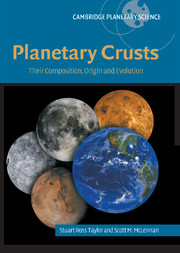Book contents
- Frontmatter
- Contents
- Preface
- Acknowledgments
- List of abbreviations
- Prologue
- 1 The planets: their formation and differentiation
- 2 A primary crust: the highland crust of the Moon
- 3 A secondary crust: the lunar maria
- 4 Mercury
- 5 Mars: early differentiation and planetary composition
- 6 Mars: crustal composition and evolution
- 7 Venus: a twin planet to Earth?
- 8 The oceanic crust of the Earth
- 9 The Hadean crust of the Earth
- 10 The Archean crust of the Earth
- 11 The Post-Archean continental crust
- 12 Composition and evolution of the continental crust
- 13 Crusts on minor bodies
- 14 Reflections: the elusive patterns of planetary crusts
- Indexes
- References
1 - The planets: their formation and differentiation
Published online by Cambridge University Press: 22 October 2009
- Frontmatter
- Contents
- Preface
- Acknowledgments
- List of abbreviations
- Prologue
- 1 The planets: their formation and differentiation
- 2 A primary crust: the highland crust of the Moon
- 3 A secondary crust: the lunar maria
- 4 Mercury
- 5 Mars: early differentiation and planetary composition
- 6 Mars: crustal composition and evolution
- 7 Venus: a twin planet to Earth?
- 8 The oceanic crust of the Earth
- 9 The Hadean crust of the Earth
- 10 The Archean crust of the Earth
- 11 The Post-Archean continental crust
- 12 Composition and evolution of the continental crust
- 13 Crusts on minor bodies
- 14 Reflections: the elusive patterns of planetary crusts
- Indexes
- References
Summary
Alphonso, King of Castille, … was ill seconded by the astronomers whom he had assembled at considerable expence (sic)…. Endowed with a correct judgement, Alphonso was shocked at the confusion of the circles, in which the celestial bodies were supposed to move. ‘If the Deity’ said he, ‘had asked my advice, these things would have been better arranged’
(Pierre-Simon Laplace)Planetary formation
Although this book is concerned with the crusts of the solid bodies in the Solar System, it is necessary to delve a little deeper into the interiors of the planets, to see how the planets themselves came to be formed and why they differ from one another. It is only possible to understand why and how crusts form on planets if we understand the reasons how these bodies came to be there in the first place and why they are all different from one another. Following 40 years of exploration of our own Solar System, the discovery of over 200 planets orbiting stars other than the Sun has brought the question of planetary origin and evolution into sharp focus. The detailed study of planets is in fact a very late event in science and has required the prior development of many other disciplines.
This highlights a basic problem in dealing with planets, at least in our Solar System, that are all quite different, so that it is difficult to extract some general principles that might be applicable to all of them.
- Type
- Chapter
- Information
- Planetary CrustsTheir Composition, Origin and Evolution, pp. 5 - 31Publisher: Cambridge University PressPrint publication year: 2008

